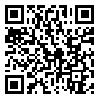Volume 2, Issue 1 (JANUARY 2003)
Payesh 2003, 2(1): 23-30 |
Back to browse issues page
Download citation:
BibTeX | RIS | EndNote | Medlars | ProCite | Reference Manager | RefWorks
Send citation to:



BibTeX | RIS | EndNote | Medlars | ProCite | Reference Manager | RefWorks
Send citation to:
Sadighi J, Madjdzadeh S.R, Younesian M, Noraei M, Jandaghi J, Kolahdoz M, et al et al . A monitoring tool in health system: "Self - assessment" method. Payesh 2003; 2 (1) :23-30
URL: http://payeshjournal.ir/article-1-850-en.html
URL: http://payeshjournal.ir/article-1-850-en.html
Sadighi J * 
 , Madjdzadeh S.R
, Madjdzadeh S.R 
 , Younesian M
, Younesian M 
 , Noraei M
, Noraei M 
 , Jandaghi J
, Jandaghi J 
 , Kolahdoz M
, Kolahdoz M 
 , Abolhasani F
, Abolhasani F 
 , Malekinejad M
, Malekinejad M 
 , Zamani G.H
, Zamani G.H 
 , Feiz-Zadeh A
, Feiz-Zadeh A 
 , Maftoon F
, Maftoon F 
 , Hadidi A
, Hadidi A 
 , Rahbar M.N
, Rahbar M.N 
 , Farivar F
, Farivar F 
 , Motalebi F
, Motalebi F 
 , Kermani A
, Kermani A 
 , Darabi A
, Darabi A 


 , Madjdzadeh S.R
, Madjdzadeh S.R 
 , Younesian M
, Younesian M 
 , Noraei M
, Noraei M 
 , Jandaghi J
, Jandaghi J 
 , Kolahdoz M
, Kolahdoz M 
 , Abolhasani F
, Abolhasani F 
 , Malekinejad M
, Malekinejad M 
 , Zamani G.H
, Zamani G.H 
 , Feiz-Zadeh A
, Feiz-Zadeh A 
 , Maftoon F
, Maftoon F 
 , Hadidi A
, Hadidi A 
 , Rahbar M.N
, Rahbar M.N 
 , Farivar F
, Farivar F 
 , Motalebi F
, Motalebi F 
 , Kermani A
, Kermani A 
 , Darabi A
, Darabi A 

Abstract: (9021 Views)
Objective(s): Client-oriented approach has been recently introduced to health services as a basis for quality improvement. The main purpose of the study was to adapt a method for development of a monitoring tools called "Self - assessment". In addition, staff opinions regarding simplicity, feasibility and workload have been investigated as part of a comprehensive assessment of this monitoring tool. Material & Methods: The first step for development of this monitoring tool was to consider quality elements in each health program based on client oriented and provider efficient approach. Then, preceding quality elements were used for developing a monitoring tool. This monitoring tool, i.e. Self- assessment, is focuses on assessment of activities by providers themselves. In addition, without any predetermined investigations; it can motivate staff for efficient service delivery by team building in health center.
For assessment, four urban health centers were selected for intervention in Semnan. Three days workshop was hold for each center. The tutors in one center were authors and in the remaining centers were district staff. Data were obtained from 42 staff in health centers by open and ended questionnaires.
Results: In three centers, which workshops were conducted by district staff, 87.5% (95% CI: 75.8 - 99.9) of staff agreed with "Self - assessment" model. The mean Point of weaknesses and strengths were 0.5 and
3.4, respectively. After a few rounds of "Self - assessment" comparing the results between centers having more versus less experties indicated that coordination with upper managerial level is crucial.
Conclusion: The "Self - assessment" monitoring method is highly focused on monitoring process and structural dimensions of quality. Looking for measuring outcomes must be considered as an essential part of a comprehensive assessment. Further evaluation of "Self - assessment" not only in comparison to other monitoring tools, e.g. "Routine supervision", but also long term effect is highly recommended before any wider implementation of this newly developed tool.
For assessment, four urban health centers were selected for intervention in Semnan. Three days workshop was hold for each center. The tutors in one center were authors and in the remaining centers were district staff. Data were obtained from 42 staff in health centers by open and ended questionnaires.
Results: In three centers, which workshops were conducted by district staff, 87.5% (95% CI: 75.8 - 99.9) of staff agreed with "Self - assessment" model. The mean Point of weaknesses and strengths were 0.5 and
3.4, respectively. After a few rounds of "Self - assessment" comparing the results between centers having more versus less experties indicated that coordination with upper managerial level is crucial.
Conclusion: The "Self - assessment" monitoring method is highly focused on monitoring process and structural dimensions of quality. Looking for measuring outcomes must be considered as an essential part of a comprehensive assessment. Further evaluation of "Self - assessment" not only in comparison to other monitoring tools, e.g. "Routine supervision", but also long term effect is highly recommended before any wider implementation of this newly developed tool.
type of study: Descriptive |
Accepted: 2018/11/28 | Published: 2003/01/15
Accepted: 2018/11/28 | Published: 2003/01/15
| Rights and Permissions | |
 |
This work is licensed under a Creative Commons Attribution-NonCommercial 4.0 International License. |



